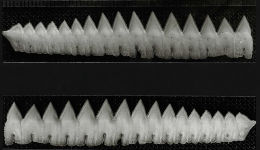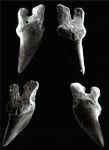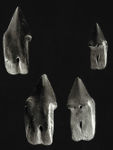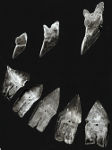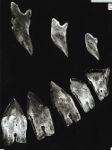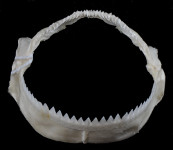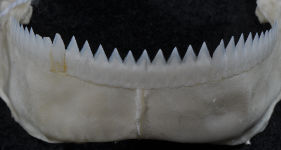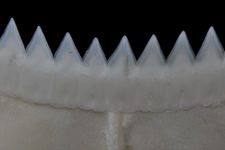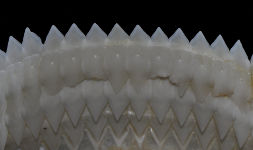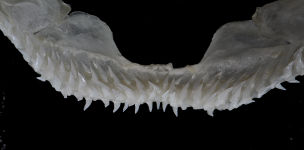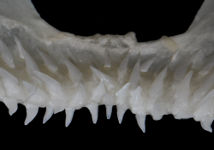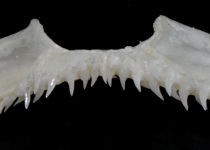Isistius brasiliensis
(Quoy & Gaimard, 1824)
Cookiecutter shark
Classification: Elasmobranchii Squaliformes Dalatiidae
Reference of the original description
Description des Poissons. Chapître IX. In Freycinet, L. de, Voyage autour du monde, entrepris par ordre du roi. Exécuté sur les corvettes de S.M. l'Uranie et la Physicienne, pendant les années 1817, 1818, 1819 et 1820. Paris. Description des Poissons. Description des Poissons. Chapter IX.: 192–401 [1–328 in 1824; 329–616 in 1825], Atlas pls. 43–65
Description des Poissons. Chapître IX. In Freycinet, L. de, Voyage autour du monde, entrepris par ordre du roi. Exécuté sur les corvettes de S.M. l'Uranie et la Physicienne, pendant les années 1817, 1818, 1819 et 1820. Paris. Description des Poissons. Description des Poissons. Chapter IX.: 192–401 [1–328 in 1824; 329–616 in 1825], Atlas pls. 43–65
Synonyms / new combinations and misspellings
Dalatias brasiliensis, Isistius aff. brasiliensis, Isistius labialis, Leius brasiliensis, Leius ferox, Scymnus brasiliensis, Scymnus brasiliensis torquatus, Scymnus brasiliensis unicolor, Scymnus torquatus, Scymnus unicolor, Scymnus (Scymnus) brasiliensis, Scymnus (Scymnus) brasiliensis torquatus, Scymnus (Scymnus) brasiliensis unicolor, Squalus fulgens
Dalatias brasiliensis, Isistius aff. brasiliensis, Isistius labialis, Leius brasiliensis, Leius ferox, Scymnus brasiliensis, Scymnus brasiliensis torquatus, Scymnus brasiliensis unicolor, Scymnus torquatus, Scymnus unicolor, Scymnus (Scymnus) brasiliensis, Scymnus (Scymnus) brasiliensis torquatus, Scymnus (Scymnus) brasiliensis unicolor, Squalus fulgens
Types
Isistius brasiliensis
Holotype: MNHN: A-7787;
Isistius labialis
Holotype: SCSFRI: S07257;
Leius ferox
Holotype: NMW: 76230;
Scymnus (Scymnus) brasiliensis torquatus
Holotype: MNHN: A-7787;
Scymnus (Scymnus) brasiliensis unicolor
Holotype: MNHN: 1178;
Isistius brasiliensis
Holotype: MNHN: A-7787;
Isistius labialis
Holotype: SCSFRI: S07257;
Leius ferox
Holotype: NMW: 76230;
Scymnus (Scymnus) brasiliensis torquatus
Holotype: MNHN: A-7787;
Scymnus (Scymnus) brasiliensis unicolor
Holotype: MNHN: 1178;
Description :
Citation: Isistius brasiliensis (Quoy & Gaimard, 1824): In: Database of modern sharks, rays and chimaeras, www.shark-references.com, World Wide Web electronic publication, Version 10/2025
Please send your images of "Isistius brasiliensis" to info@shark-references.com
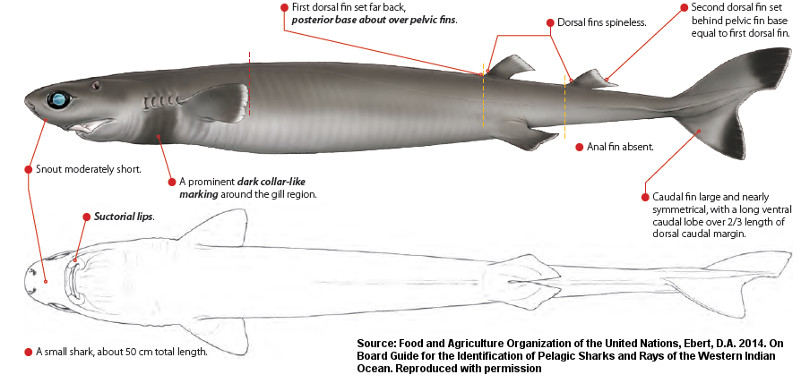
Isistius brasiliensis (Quoy & Gaimard, 1824), © FAO, Food and Agriculture Organization of the United Nations, Ebert, D.A. 2014. On Board Guide for the Identification of Pelagic Sharks and Rays of the Western Indian Ocean. Reproduced with permission, illustration by Marc Dando , Wildlife Illustrator

Isistius brasiliensis (Quoy & Gaimard, 1824), © FAO, Food and Agriculture Organization of the United Nations, Ebert, D.A. 2014. On Board Guide for the Identification of Pelagic Sharks and Rays of the Western Indian Ocean. Reproduced with permission, illustration by Marc Dando , Wildlife Illustrator
Common names
 Kleiner Leuchthai,
Kleiner Leuchthai,  Tiburón cigarro,
Tiburón cigarro,  Tiburón puro,
Tiburón puro,  Tollo cigarro,
Tollo cigarro,  Squalelet féroce,
Squalelet féroce,  Cigar shark,
Cigar shark,  Cookie cutter shark,
Cookie cutter shark,  Cookie-cutter shark,
Cookie-cutter shark,  Cookiecutter shark,
Cookiecutter shark,  Luminous shark,
Luminous shark,  Smalltooth cookiecutter shark,
Smalltooth cookiecutter shark,  Smooth cookiecutter shark,
Smooth cookiecutter shark,  Cação luminoso,
Cação luminoso,  Cação luminosos
Cação luminosos
 Kleiner Leuchthai,
Kleiner Leuchthai,  Tiburón cigarro,
Tiburón cigarro,  Tiburón puro,
Tiburón puro,  Tollo cigarro,
Tollo cigarro,  Squalelet féroce,
Squalelet féroce,  Cigar shark,
Cigar shark,  Cookie cutter shark,
Cookie cutter shark,  Cookie-cutter shark,
Cookie-cutter shark,  Cookiecutter shark,
Cookiecutter shark,  Luminous shark,
Luminous shark,  Smalltooth cookiecutter shark,
Smalltooth cookiecutter shark,  Smooth cookiecutter shark,
Smooth cookiecutter shark,  Cação luminoso,
Cação luminoso,  Cação luminosos
Cação luminosos
Short Description
Original Diagnosis after EBERT [22775]: Field Marks: Small sized sharks with cigar–shaped body, short, bulbous snout, suctorial lips, small, triangular–cusped lower teeth without blades and in 25 to 31 rows, spineless dorsal fins far posterior on back, no anal fin, nearly symmetrical caudal fin with long ventral lobe and a prominent dark collar–marking over branchial region. Diagnostic Features: Snout moderately short, about length of eye. Eyes anterior on head but sufficiently far back to lack an extensive anterior binocular field. Teeth in upper jaw 30 to 37, lower jaw 25 to 31; lowers moderately large. Interdorsal space over twice first dorsal–fin base, space between second dorsal–fin insertion and upper caudal–fin origin over twice second dorsal–fin base. Pectoral fins subquadrate, pelvic fins larger than dorsal fins. Second dorsal–fin height about equal to first. Caudal fin large and nearly symmetrical, with a long ventral caudal–fin lobe over 2/3 length of dorsal caudal–fin margin. Vertebral counts: total vertebral counts 81 to 89, precaudal vertebral counts 60 to 66, caudal vertebral counts 20 to 24. Intestinal valve turn counts 8 to 10. A small shark with a maximum total length of about 56 cm. Colour: pale brown above, becoming lighter below, with a conspicuous dark collar–like marking around the gill region; fins dark, but with pale to translucent edges.
Original Diagnosis after EBERT [22775]: Field Marks: Small sized sharks with cigar–shaped body, short, bulbous snout, suctorial lips, small, triangular–cusped lower teeth without blades and in 25 to 31 rows, spineless dorsal fins far posterior on back, no anal fin, nearly symmetrical caudal fin with long ventral lobe and a prominent dark collar–marking over branchial region. Diagnostic Features: Snout moderately short, about length of eye. Eyes anterior on head but sufficiently far back to lack an extensive anterior binocular field. Teeth in upper jaw 30 to 37, lower jaw 25 to 31; lowers moderately large. Interdorsal space over twice first dorsal–fin base, space between second dorsal–fin insertion and upper caudal–fin origin over twice second dorsal–fin base. Pectoral fins subquadrate, pelvic fins larger than dorsal fins. Second dorsal–fin height about equal to first. Caudal fin large and nearly symmetrical, with a long ventral caudal–fin lobe over 2/3 length of dorsal caudal–fin margin. Vertebral counts: total vertebral counts 81 to 89, precaudal vertebral counts 60 to 66, caudal vertebral counts 20 to 24. Intestinal valve turn counts 8 to 10. A small shark with a maximum total length of about 56 cm. Colour: pale brown above, becoming lighter below, with a conspicuous dark collar–like marking around the gill region; fins dark, but with pale to translucent edges.
Distribution
Western Atlantic: Bahamas and southern Brazil. Eastern Atlantic: Cape Verde, Guinea to Sierra Leone, southern Angola and South Africa, including Ascension Island. Indo-Pacific: Mauritius to New Guinea, Lord Howe Island, and New Zealand [578], north to Japan and east to the Hawaiian Islands. Eastern Pacific: Easter Island (Ref. 9068) and the Galapagos.
First record [22877]: North Pacific Ocean, female 432 mm in total length, was caught in a sablefish pot at a depth of 1132 m off San Nicolas Island, California, USA (32 59′05′′N 120 25′99′′W). Source: www.gbif.org
Western Atlantic: Bahamas and southern Brazil. Eastern Atlantic: Cape Verde, Guinea to Sierra Leone, southern Angola and South Africa, including Ascension Island. Indo-Pacific: Mauritius to New Guinea, Lord Howe Island, and New Zealand [578], north to Japan and east to the Hawaiian Islands. Eastern Pacific: Easter Island (Ref. 9068) and the Galapagos.
First record [22877]: North Pacific Ocean, female 432 mm in total length, was caught in a sablefish pot at a depth of 1132 m off San Nicolas Island, California, USA (32 59′05′′N 120 25′99′′W). Source: www.gbif.org
Human uses
fisheries: minor commercial; price category: not marketed/unknown; price reliability:
fisheries: minor commercial; price category: not marketed/unknown; price reliability:
Biology
Presumably ovoviviparous; 6 or 7 large eggs have been found in ovaries [518]. Distinct pairing with embrace [17086]. Viviparous, without a yolk sac placenta, 6-12 young per litter. Males mature at about 36 cm, with a maximum length of 42 cm; females mature at 39 cm, with a maximum length of 56 cm. Size at birth is unknown. (Ref. 48844).
Presumably ovoviviparous; 6 or 7 large eggs have been found in ovaries [518]. Distinct pairing with embrace [17086]. Viviparous, without a yolk sac placenta, 6-12 young per litter. Males mature at about 36 cm, with a maximum length of 42 cm; females mature at 39 cm, with a maximum length of 56 cm. Size at birth is unknown. (Ref. 48844).
Remarks
shark-references Species-ID=3200;
shark-references Species-ID=3200;













